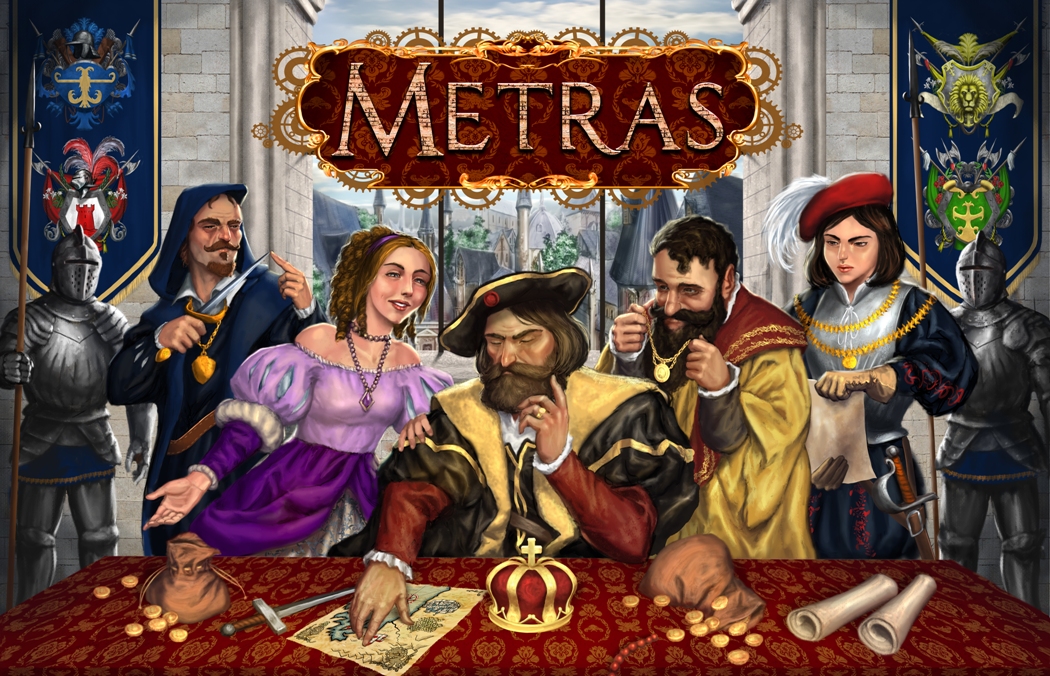Let’s re-start our journey inside Metras from the Cards, which are divided in Mission Cards and Action Cards.
Mission Cards, besides being used as Turn trackers, represent a particular mission of exploration that your Family could fulfil in the name of the Emperor.


On each card an Exploration requirement is indicated (on the top) and a reward in Influence Points (on the bottom). Eventually, as in the picture on the right, there can be an Action to carry out.
The requirement of Exploration represents the minimum scoring value of Exploration that your Noble Family must have.
The Action Cards which allow you to attempt a Mission of Exploration can increase your Exploration score for the purposes of meeting the requirement (as we will see later on).
The Action Cards, through their acquisition during the Bidding Phase, allow players to resolve actions shown on them during the Resolution Phase.
The Action Cards are divided in two types: Deck I and Deck II. The first deck is used for turns 1, 2 and 3, while the second is used for turns 4 and 5.


We can tell you right now that with 4 players, 3 cards in each deck won’t be used, ensuring in this way a certain variability of the games and a lack of certainty about the remaining actions in the deck.
Like for the Branches, cardsc are of 4 types, each of them is applicable to a different Branch.

Cards associated with Fame will simply allow you to obtain Influence Points equal to the Fame Value of your Noble Family, multiplied by the number shown on the card.

Cards associated with Exploration are made in two parts:
– The value beside the sextant (on top) represents the multiplier of the Exploration score of your Noble Family according to the requirement of the Missions;
– The value beside the laurel (on the bottom) represents the multiplier of the Influence Points gained present on the Mission Card inside the crown of laurels. If the Mission Card allows you to gain other Influence Points thanks to the extra Action conceded, these will not be multiplied.
The cards associated with Wealth allow players to Recruit new Allies (picture on the left) or to take an action of Reorganization of the owned Allies (picture on the right).

– Recruit: the number beside the eye shows how many Allies are pulled out from the bag; while the number beside the hand shows how many of them can be kept and placed either on a Branch or on Reserve. We would like to remind you that in every Branch a maximum number of Allied/Servants/Incompetents equal to the number of the on-going turn can be present.

– Rearrange: this action allows players to redeploy the owned Allies / Servants / Incompetents among the various Branches while respecting the limits given by the turn. The scores of the Branches will be adjusted consequently.
The cards associated with Intrigue are the most dangerous and those ones which allow the most ruthless and direct interaction inside a game of Metras.
Intrigue allow players to target a rival Family which has a Wealth score less than the own Intrigue score (“less”, not “equal to” or “more than”!).
4 different actions are possible:

– Theft: you steal a number of Influence Points equal to your own Intrigue score from the rival Family, eventually multiplied with the value besides the lock icon and from the bank the same amount of IP, eventually multiplied with the value besides the coffer;

– Corruption: you steal an Ally (golden border) from the rival Family and you will place it immediately in one of your Branch, considering the turn limits, or in Reserve;

– Treachery: allows you to execute against the targeted Family firstly a Bribe and then a Theft (without taking away any money from the bank though);

– Assassination: you eliminate an Ally (golden border) of the rival Family from the game. The opponent will be able to substitute it with an Incompetent.
Last, but not less important, let’s take a look at the Allies, the Servants and the Incompetents, who will be placed on a side of a Branch, highlighting in this way the numerical value that will modify the score in that particular Branch.
Allies are the most powerful characters: they are very good in a Branch, capable in another, but lack in the other two branches.

Servants distinguish themselves with the colours of the various Families on the corners and with good scores in two Branches and poor scores in the other two, from those “non-starting” which have a value of “2” in all four Branches.


Incompetents are the substitutes of your dead Allies, and are quite hopeless in all 4 Branches, with a value equal to “1”.

Next time we will take a look in detail at the turn sequence and the various phases.





